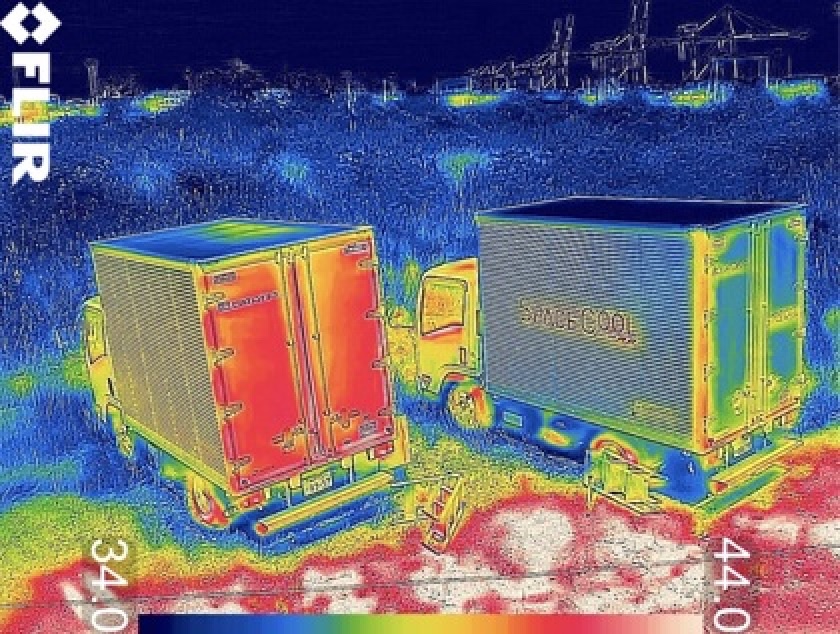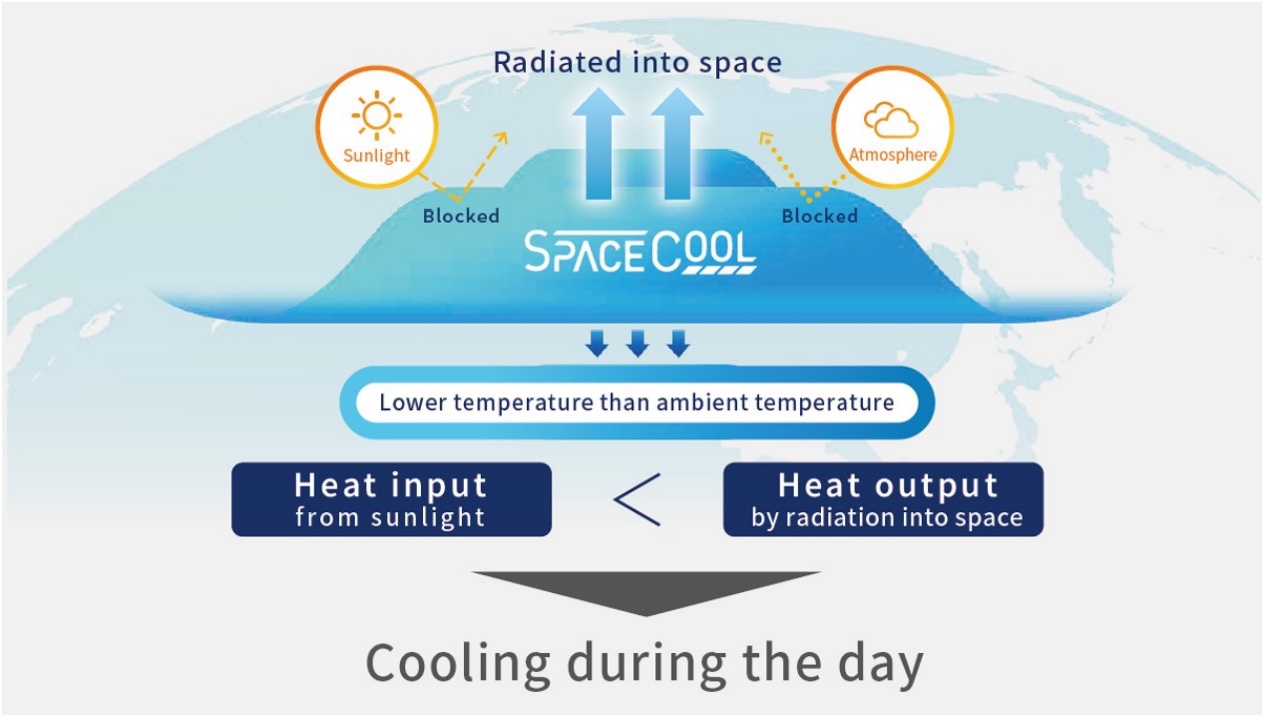

SPACECOOL®:連接到外部以冷卻內部:
-不使用能源即可冷卻的材料-
空間冷卻®:
推出無需能源即可冷卻的材料“SPACE COOL®”。
帶膠光學膜:
它安裝在配電盤和卡車的外部,內置精密設備,以抑制內部溫度升高。
“SPACE COOL®”規格:
尺寸為 1.25 寬 x 25 米長
厚度為 0.11 毫米
以捲筒形式提供。
顏色:銀色和白色兩種。
價格沒有透露。
對於熱對策,價格與太陽能反射漆相同。
“SPACE COOL®”的原理:
該材料阻擋來自陽光和大氣的熱量並抑制熱量吸收。
利用“熱輻射”原理作為電磁波。
降低不使用能量構造的物體的溫度。
由大阪燃氣開發:
夏季使用2噸卡車進行了示範實驗。
當卡車暴露在陽光直射下時,測量外部和裝載平台的溫度。
用 2 噸卡車進行實驗:
與什麼都沒有建造的卡車相比
天花板溫度下降 40 度到 30 攝氏度,
經證實,內部溫度下降了 10 度至 33 攝氏度。
新開關
SPACECOOL® : Attaché à l’extérieur pour rafraîchir l’intérieur :
-Matière qui refroidit sans utiliser d’énergie-
SPACECOOL® :
Lancement de “SPACE COOL®”, un matériau qui peut être refroidi sans utiliser d’énergie.
Film optique avec adhésif :
Il est fixé à l’extérieur des tableaux de distribution et des camions avec un équipement de précision intégré pour supprimer l’élévation de température à l’intérieur.
Spécifications “SPACE COOL®”:
La taille est de 1,25 largeur x 25 mètres de long
L’épaisseur est de 0,11 mm
Fourni sous forme de rouleau.
Couleur : Deux types, argent et blanc.
Le prix n’est pas communiqué.
Pour les contre-mesures thermiques, le prix est le même que celui de la peinture réfléchissante solaire.
Principe du « SPACE COOL® » :
Le matériau bloque la chaleur du soleil et de l’atmosphère et supprime l’absorption de chaleur.
Utilise le principe du « rayonnement thermique » comme onde électromagnétique.
Abaissez la température de l’objet construit sans utiliser d’énergie.
Développé par Osaka Gas :
Réalisation d’une expérience de démonstration à l’aide d’un camion de 2 tonnes en été.
Lorsque le camion a été exposé à la lumière directe du soleil, la température de l’extérieur et de la plate-forme de chargement a été mesurée.
Expérimentez avec un camion de 2 tonnes :
Comparé à un camion sans rien construit
La température du plafond baisse de 40 degrés à 30 degrés C,
Il a été confirmé que la température interne a chuté de 10 degrés à 33 degrés C.
Nouvel interrupteur
SPACECOOL®: Außen angebracht, um innen zu kühlen:
-Material, das energielos kühlt-
SPACECOOL®:
Markteinführung von „SPACE COOL®“, einem Material, das energielos gekühlt werden kann.
Optischer Film mit Klebstoff:
Es wird an der Außenseite von Verteilern und Lastwagen mit eingebauter Präzisionsausrüstung angebracht, um den Temperaturanstieg im Inneren zu unterdrücken.
„SPACE COOL®“-Spezifikationen:
Die Größe beträgt 1,25 Breite x 25 Meter Länge
Die Dicke beträgt 0,11 mm
Lieferung in Rollenform.
Farbe: Zwei Typen, Silber und Weiß.
Der Preis wird nicht bekannt gegeben.
Bei Wärmeschutzmaßnahmen ist der Preis derselbe wie bei reflektierender Sonnenfarbe.
Prinzip von „SPACE COOL®“:
Das Material blockiert Wärme vom Sonnenlicht und der Atmosphäre und unterdrückt die Wärmeabsorption.
Verwendet das Prinzip der “Wärmestrahlung” als elektromagnetische Welle.
Senken Sie die Temperatur des konstruierten Objekts, ohne Energie zu verbrauchen.
Entwickelt von Osaka Gas:
Durchführung eines Demonstrationsexperiments mit einem 2-Tonnen-LKW im Sommer.
Bei direkter Sonneneinstrahlung des Lkw wurde die Außen- und Ladeflächentemperatur gemessen.
Experiment mit einem 2-Tonnen-LKW:
Im Vergleich zu einem LKW, der nichts gebaut hat
Deckentemperatur sinkt um 40 Grad auf 30 Grad C,
Es wurde bestätigt, dass die Innentemperatur um 10 Grad auf 33 Grad C gefallen ist.
Neuer Schalter
Joint Study for Sales of SPACECOOL®, a New Material Using Radiant Sky Cooling Technology
SPACECOOL Inc. (SPACECOOL)
The Material was independently developed by Osaka Gas using its own technology
and can be applied to
liquefied petroleum gas (hereinafter, “LPG”) vessels,
LPG tanks for land storage,
LPG transport vehicles and rail cars,
vessels for grain and storage silos for grain.
The Material is a new material
that can realize a decrease in temperature without using energy through radiant sky cooling technology that release heat into space (*1).
The heat generated by sunlight on the earth’s surface
is constantly dissipated into space, but partially absorbed by carbon dioxide and water vapor,
and remains in the atmosphere, leading to global warming.
Since the Material emits infrared wavelengths
that are not easily absorbed by carbon dioxide and water vapor, the heat can be released into space without remaining in the atmosphere.
In a demonstrative experiment conducted by Osaka Gas,
it was confirmed that the surface temperature of the Material was about 6℃ (*2) lower than the outside temperature in direct sunlight.
It has the world’s highest level of cooling performance (*3)
and is expected to be increasingly used as measures against global warming, energy conservation and the need for natural cooling comfort rise.
It has the world’s highest level of cooling performance (*3)
and is expected to be increasingly used as measures against global warming, energy conservation and the need for natural cooling comfort rise.
News